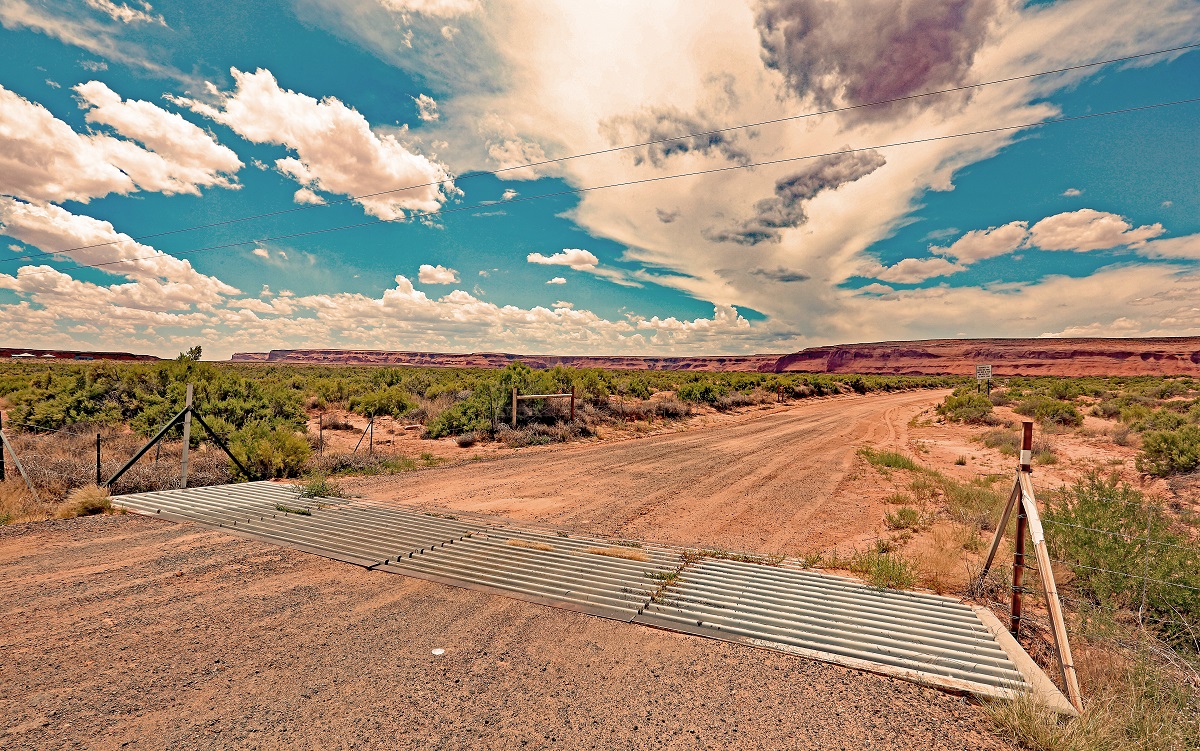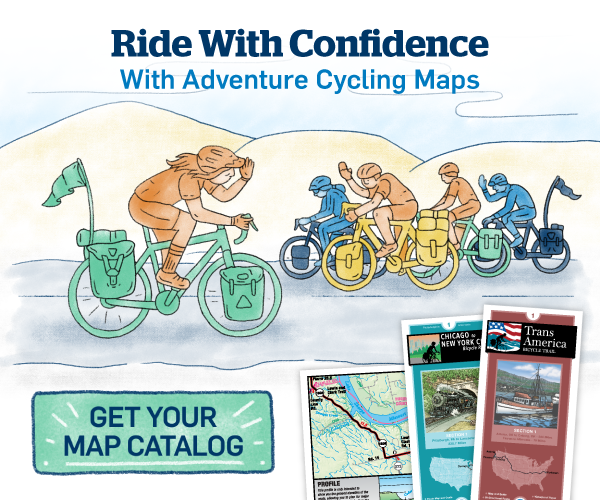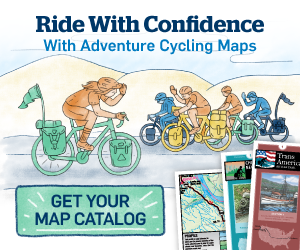Six Road Hazards to Heed
Traveling cyclists must consider many things when preparing for a stint on the road, and we tend to focus our attention on things related to food, shelter, and routes. However, as loaded touring cyclists, we may need to pay more attention to another item: road hazards.
On unloaded, go-fast bikes, it’s easier to stop or maneuver quickly around hazards. But on our gear-laden, traveling steeds, the following road features can quickly become pitfalls.
1. Cattle guards
These grids of metal slats found across the rural US keep cattle and other livestock from crossing into other pastures and can be a threat to cyclists if not approached with caution. A heartbreaking example occurred just this summer when cyclist Frank Uher, traveling from Missoula to Denver with his brother and friends, approached the Split Rock National Historic Site. Frank’s front wheel was caught in a gap in a cattle guard, causing him to lose control and be thrown from his bike. He landed head first on the pavement and passed away at the scene.
The design of the four-panel cattle guards makes them particularly hazardous, so the Bureau of Land Management is working with the state of Wyoming to create a safer design and place hazard signs at the cattle guards.

When approaching any cattle guard, cyclists should be aware that the spacing between slats can vary, and there may be other gaps associated with the guard. It’s best to cross slowly, as perpendicular as possible, and when in doubt, walk your bike.
2. Dogs
Though Kentucky often gets a bad “rep” for dogs, loose Fidos can be encountered anywhere. While chasing moving objects is an innate behavior for dogs, most canines aren’t out to viciously attack. The best method of defense is to stop riding, get off the bike and keep the bike between you and the dog.
3. Railroad crossings
Most traveling cyclists will encounter railroad crossings on tour, and will often go out of the way to avoid the worst of them on commutes and recreational rides. Most importantly when crossing, check for trains and traffic and cross the tracks at a 90-degree angle or perpendicular to the gaps. This means you might have to veer across the road in order to stay perpendicular to the tracks, so cross only in low or no traffic.
4. Thick gravel and chip seal
Gravel and chip seal can cause instability and difficulties while pedaling down the road. On my recent long-distance trip, I unwittingly routed myself onto a number of Wisconsin “rustic roads” and endured some of the scariest, most difficult riding of my 2000 miles. I frequently felt as though I was about to fall over. Holding a steady line proved nearly impossible. I quickly routed myself over to the parallel highway and breathed a sigh of relief.
5. Menacing metal
Manhole covers, sewer grates, open grated bridges — all of these have three words in common: slippery when wet. Not only could your wheels slide out from underneath you, but metal can also be loose or uneven, causing pinch flats. Some have gaps, causing your wheels to become trapped. It's best to avoid them but if you must ride over them, ride straight and try to refrain from braking or turning.
6. Cracks, filled and unfilled
Roads settle and heave, and sometimes the resulting cracks can eat your wheel. It’s best to avoid them if you can and cross them as perpendicularly as possible when you can’t. The flip side of these cracks is when they’ve been repaired and filled with tar: on particularly hot days the tar reheats and turns squishy and slippery. This is a hazard, not only on roads but paved, multi-use paths.
This story has been updated and was originally published on October 18, 2017.


Comments
On my 15-mile daily commute to work along rural roads, I would often pass a farmhouse that had 3 feisty dogs in the yard. Most days, the feistiest of the bunch would jump the fence and charge at me as I passed by on the county road. Of course, this happened sometimes just as a car was passing me on the left, giving me no option but to stop and try to keep my bike between me and the canine as a car (or semi) wooshed by a foot from my backside.
Enter bear spray.
I had a can I had kept from my last work assignment in Alaska. It fits perfectly in a water bottle cage. The next time we met, I blasted that dog in the face just as it lunged to bite my foot/pedal and it stopped him dead in his tracks. The next day he came charging out as usual, hopped the fence, but you could see the gears turning in his head as he 'remembered' what had transpired the day prior and stopped about 30 feet from me and just watched as I whizzed by. He was never a problem again.
In British Columbia, Canada, the cattle guards are constructed of pipe spaced equidistant apart. I first encountered one at the bottom of a hill, traveling fast, I tried to hop over it. Unlike the U.S. guards with flat tops, I didn't skim over the bars. How I didn't break my fork.....I then tried to walk over the next one. How I didn't break an ankle.....I guess that's a lesson in not assuming :)
From the header illustration I was sure you were going to discuss riding into the rising or setting sun - early rides along a west bound road make us very invisible... as does heading for camp east bound at the end of a long & scenic day...
Normally I'll ride in the lane to be seen as soon as possible, but at these times I'll stay over on the shoulder if available. It's also really pleasant to stop & enjoy a road side coffee or second breakfast - or take in the sunset & resume riding after the motorists are less blind.
Please add speed bumps to your list. One of my friends flew over a slippery one and severely broke his hip and my
son hit one unexpectedly and broke his wrist
The worst hazard are CARS. I ride on all public streets. The busier the street the greater chance of being side swipped or even being hit by a car. I recently purchased a flag that sticks out 3 feet in the direction of traffic. It keeps cars and trucks at least (3) three feet from your body. The website to purchase this is: "Http://www.TakeYourLane.com". I have recommended this to everyone who rides bikes. (PS: This is not my company.)
One that I encounter on a paved multi-use path and would be a concern for rail-to-trail systems as well is tree roots upheaving the pavement. Even potentially small bumps have caused me issues, especially when something isn't as secured as I thought it was...
When riding on the C&O Canal (the CO part of GAPCO) be mindful of the stone aquaduct and canal locks you must cross, especially when they are wet. I learned this through the school of hard knocks and the tutition was a set of cracked ribs with 150 miles left to ride!
I once encountered a series of short fresh road repairs. On one it was so fresh the tar was still sticky. After crossing it and immediately picking up gravel and grit on the shoulder I had chip and seal tires for the next few miles, it was like riding on loose gravel till the tar wore off.
For loose dogs I miss my old frame pump. After a good wack on the nose from it that dog will never chase bikes again.
I've seen what I would call, "faux" cattle guards. The guards are painted on the pavement, good enough to fool the cattle, and at first glance good enough to fool me.
As to crossing them, I've taken the route to crossing them at a right angle, making sure I've got enough speed to clear the guards. What I never want to do is have to stop on the guard, and at my age walking across posses it's hazard.
Other hazards to watch for include narrow anti-car barriers occasionally found at road crossings on bike paths, traffic channeling bubbles sometimes found at intersections but I also have seen them used to separate protected bike lanes from traffic lanes and green lights that don't last long enough for you to cycle across an intersection. I'm increasing finding intersections where the green light lasts as little as 5 seconds.
Bridge expansion joints can be very dangerous. They are designed to allow the movement of bridge sections and are therefore continually changing.
Avoid if the sign says motorcycles beware, often construction steel across the road or a section of it. Also rumble strips can be a big issue.
Forgot Password?
Enter your email address and we'll send you an email that will allow you to reset it. If you no longer have access to the email address call our memberships department at (800) 755-2453 or email us at memberships@adventurecycling.org.
Not Registered? Create Account Now.